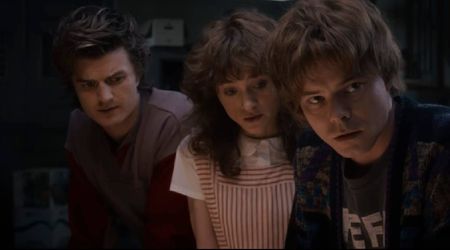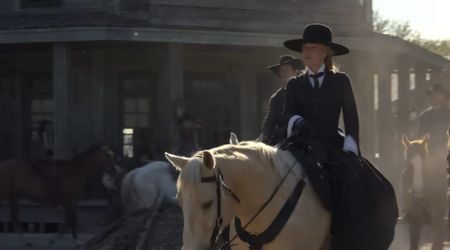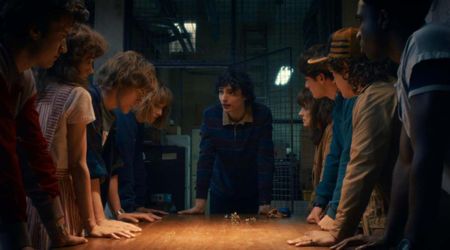'Buried Worlds with Don Wildman' Episode 7: Wildman taps into some ancient ritualistic mysteries in Britain

Wildman journeys across the pond to explore some of the British Isles' well-known yet hidden mysteries in the latest episode of 'Buried Worlds with Don Wildman'. He inspects an ancient cave riddled with strange carvings that he learns are called 'witches marks'. He explores how these marks may be linked to the supernatural, visits holy wells and dives into an eerie shipwreck, where he meets modern-day Druids while investigating if a historical bloody battle ended with a deadly curse.
Witches marks - Creswell Crags
The East Midlands in England boasts of the nation's scenic countryside. Located some 150 miles north of London is Creswell Crags, a place known for its limestone gorges filled with dozens of caves, that are alleged to have been in human use for at least 20,000 years. In 2019, the area made headlines when hundreds of protective marks or 'Witches Marks' dating back to medieval times were discovered in these caves. Believed to be the largest concentration of protective marks ever found in the UK, they were inscribed onto the walls of the cave because they were thought to ward off evil spirits coming from the underworld.

Originally thought to be plain graffiti, the 'apotropaic' marks cover every inch of the cave's surface. Historically, the largest quantity of these 'witches marks' were the 57 markings that were sound in a Somerset cave, but that changed with the discovery. There is a possibility that this cave was thought to be a portal to the underworld used by demons and witches between the 16th and 18th centuries. The apotropaic markings comprise several letters, symbols and patterns that may have been carved at a time when there was a predominant belief in witchcraft and the dark arts. The protection marks include the double V, a reference to Mary, the Virgin of Virgins; PMs as in Pace Maria; crossed Is referring to Jesus on the cross and oddly-shaped As. There are also diagonals lines, boxes and mazes which are believed to be symbols that capture or trap evil.
Also known as apotropaic marks, originating from the Greek word 'apotrepein' meaning 'to turn away', they were etched onto stone or woodwork. These ritualistic protection marks are most commonly found in medieval churches and houses in entryways, particularly on doors, windows, and fireplaces. They were believed to protect residents and visitors from evil spirits and witches. Some of these marks have also been found at Shakespeare's birthplace and even spotted in medieval barns, where they were carved into ancient timber to protect crops.

Some of these markings, Wildman learns were made two or three centuries ago, while others had been carved into the walls of the cave thousands of years ago. The frequency of the markings implies that people were very worried about something. Wildman hopes to find what evil resided in these caves that terrified the locals, and if they still exist there today. So he contacted a psychic medium to find out. The medium senses that the deeper you go into the cave, the energies get darker. The two approach an area that is directly below a ceiling with the highest concentration of marks. The medium then tells Wildman the energy here is more sinister and that he senses a satanic spirit, which may possibly be thousands of years old. They receive responses on various EMF (electro-magnetic field) equipment, just as the medium tries to communicate with these dark entities.
Holy Wells - Portrane, Ireland
For centuries, mysterious waters bubbling up from the ground in various village centers across Ireland were believed to have magical powers. Many claim, however, that there are others that have the power to curse. These mysterious waters are deemed 'Holy Wells.' They are thought to have the power of curing illnesses through rituals and also cursing third parties. Water worship has been a part of Irish culture for hundreds and most likely thousands of years. Visting Holy Wells was very popular, particularly during the reign of Henry VIII in the 16th century and during the enforcement of the Penal Laws in the 18th century. In these periods, religious houses were closed and prosecuted people had to find an alternate place of worship.

Wildman meets a spiritual guide with knowledge about these wells, and also how they may have a link to the curses that have plagued the British Isles. The well that Wildman is exploring is located inside of a cave that remains submerged beneath the ocean, for most of the day. The cave is located at the edge of the sea, where saltwater mixes with freshwater, twice a day, but the water in the well remains fresh. Thousands of years ago, the ancient Irish believed that this was powerful, magical water from another realm, released by the earth. The guide told Wildman, that despite people believing these waters had magical properties, it could be either highly creative or destructive and used for curses. The ancient Irish would harness the power of the waters to curse their enemies by inflicting terrible illnesses, calling on rains to drown their villages, or summoning lightning to set their houses on fire.
Shipwreck - Dublin
The Irish Sea, just off the coast of Dublin, Ireland, is known as the Bermuda Triangle of the British Isles. An inordinate number of ships have met a tragic fate along this small stretch of water, Wildman says. He intends to explore one of Ireland's most famous shipwrecks, still sunken at the bottom and shrouded in mystery, the RMS Tayleur and wants to find out if it was wrecked as a result of the cursed waters. Wildman meets a ship captain, well-versed in Irish legends, who guides him through the mystery of the notorious shipwreck.

The RMS Taylor was hailed the biggest and fastest vessel of the time, made to be unsinkable and set out on its maiden voyage in January 1854. She departed from Liverpool, with 650 passengers and crew on board and was bound for Australia. Two days after departure, the weather took a drastic turn and high winds as well as thick fog, made it difficult for the crew to steer the ship. As a result, she crashed onto the rocks around Lambay Island and sank to the bottom of the ocean taking 350 passengers along with her. Out of the 290 survivors, only three women and three children made it to shore alive. Many of these survivors blamed the incident on strange and lethal phenomena that occurred just before the tragedy. Wildman decides to dive to the bottom of the sea to explore the mystery for himself. Along with a group of divers, he swims to the depth of the Irish Sea seeking the ruins of the RMS Tayleur, which now sits at the bottom covered in Corals.
Druids - Anglesey, Wales
The Celts ruled the British Isles from as early as 300 BC. The Druids were their high priests, who were also said to be powerful magicians. The tales of the curses of the Irish Seas have been associated with the Druids, believed to have left their magic behind to drag down people as a reminder of their prominence. The Druids were wiped out by the Romans, some 2,000 years ago and not much is known about them because they didn't have a written language. Wildman travels to Anglesey Wales, where he meets two modern-day Druids. Modern Druidry continues the knowledge of nature, one of the Druids tells him, adding, "We are part of nature and nature is part of us." The Druids knew secrets spells that enabled them to tap into supernatural powers locked inside the earth. Wildman observes as the two Druids perform a ritual to honor their ancestors. Modern-day Druids use offering for healing, but the original Druids also drew power from dark forces of nature to create poisons and cast spells.

Bryn Celli Ddu is an ancient burial mound that has been sacred to people for thousands of years, but especially the Druids. The stone mound has been abandoned for centuries and Wildman finds the place to be supernatural and eerie as ancient Druids are believed to have performed powerful magic here and plans to explore it. The Druids perceived this place as a bridge between the underworld, the earth and the heavens. Wildman reveals that bones were discovered inside the mound, some charred, hinting at death rituals being carried out by ancient Druids and the Romans also documented the Druids being involved in bloody rituals.
'Buried Worlds with Don Wildman' premieres on Mondays at 9 pm ET/PT on the Travel Channel.










